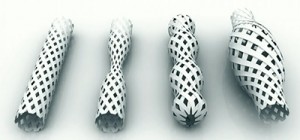4D (Not 3D) Printing
October 12, 2015

According to Andy Pye in the UL Prospector, “4D printing … consists of smart materials that adapt and re-programme their properties, functionality or shape on demand, based upon external stimuli (such as submersion in water, or exposure to heat, pressure, current, ultraviolet light, or some other source of energy).”
So far, the materials appropriate for this transformation are limited to programmable carbon fiber, wood grain, and textiles. Andy states, “researchers are combining different types of plastics and fibres to create smart materials that self-assemble or change shape after 3D printing. Here, the fourth dimension relates to the time taken for the self-transformation.” Examples of 4D printing have included simple self-assembling bodies that fold together when baked, polymers that bend into shape in response to water, heat or pressure, and smart strands inspired by self-assembling nanostructures.”
Look for this technology to blossom soon in the fields of aerospace, automotive, clothing, construction, military, healthcare and utilities.
Steve Ritch
Manager
Job Placement Resource Center
Harper College


